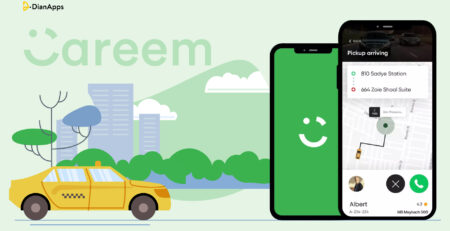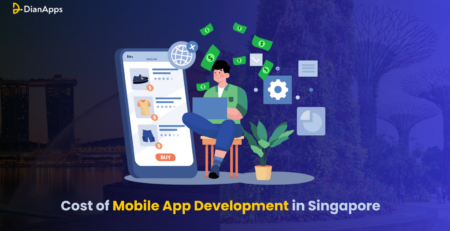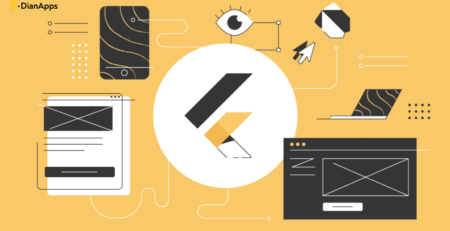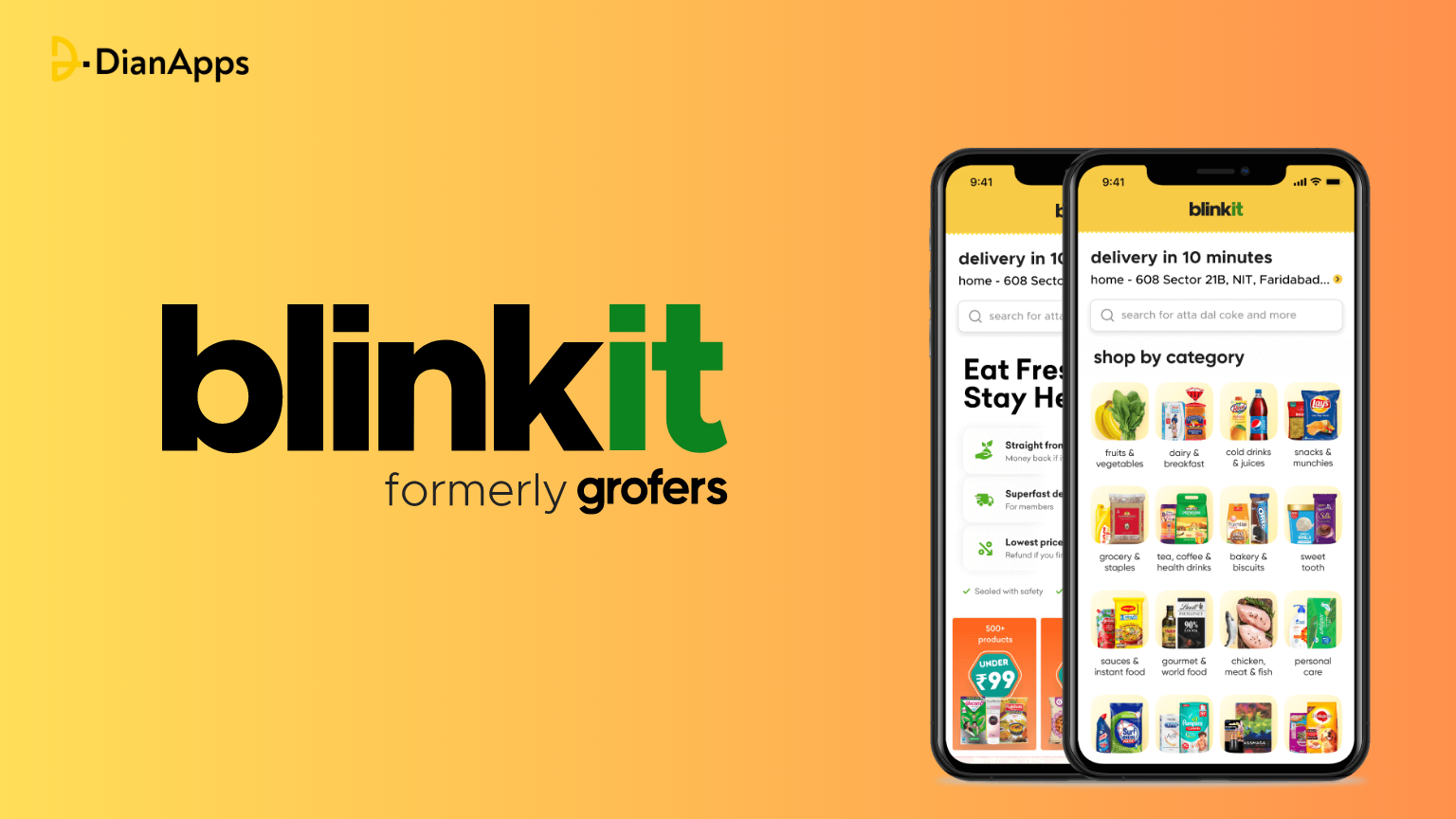The Future is Here: A Guide to Building a Grocery Delivery App
In today’s fast-paced world, people are always on the go, therefore having a convenient way to access food is essential. That’s where the idea of grocery and food delivery app development comes in.
Grocery delivery apps have become a ubiquitous part of our daily lives. With just a few taps on our smartphones, we can have our favorite meals or groceries delivered right to our doorstep. They are the perfect solution for busy individuals who want to have a meal without having to leave the comfort of their homes. But what is it that makes these apps so popular and why should you consider building one?
But why should you build a Grocery delivery app? And how does it work? In this blog, we will explore the reasons for building an app, the different business models involved, the key features, and the step-by-step guide to developing a grocery delivery app. We will also discuss the challenges faced during the development process and the overall costs involved. Ultimately, we will talk about why building a grocery delivery app with DianApps is the way to go.
Why Build a Grocery Delivery App?
Stuck on the thought that whether you should build a grocery delivery app?
Building a grocery delivery application may be just an opportunity you’ve been looking for. With the COVID-19 pandemic driving more and more consumers to online grocery shopping, now is the time to grab a slice of the lucrative pie.
On-demand app development provides convenience to your customers. It includes access to your entire product catalog, providing a new channel for increasing sales and attracting new customers. By investing in this rapidly growing industry, you’ll be positioned to take advantage of the growing demand for online grocery shopping.
So why build a grocery delivery app? The answer is clear – to tap into a rapidly growing market and provide customers with an easy and convenient way to access your products. If you’re ready to join the online grocery shopping revolution, it’s time to start building your app.

Interesting statistics highlight the growth potential of the online grocery shopping market:
- Nearly half of all grocery customers purchase some of their products online.
- Digital grocery sales in the US are projected to reach a staggering $59.5 billion by 2023.
- By 2025, online grocery sales are expected to account for 21.5% of total US grocery sales, more than double its current market share.
- Walmart is expected to generate $37.6 billion in online grocery sales in 2022 and Amazon is to bring in over $72 billion.
- Statistics show that the market for online grocery shopping will experience significant growth. Anticipatingly, $177.17 billion increase in spending between 2019 and 2025, quadrupling in just six years.
These statistics demonstrate the immense growth potential of the online grocery shopping market. Thus making it an exciting opportunity for those considering building a grocery delivery app.
Read out to know more about the app development trends to look out in 2023
What benefits does Grocery Delivery App Development bring to the Business?
You can develop a grocery delivery application to start a new business or to extend the operating horizons of the existing one. Why would creating a platform for grocery delivery be profitable for your businesses? Let’s find out.
Higher Demand
The demand for grocery delivery apps has skyrocketed in recent years, and it’s only going to increase. People are looking for quick, convenient, and affordable options when it comes to food and groceries, and grocery delivery apps provide just that.
Competitive Advantage
Building a grocery delivery app can give you a competitive advantage in the market. With an app, you can reach more customers, offer better service, and increase your brand’s visibility.
Improving Customer Experience
Grocery delivery apps can greatly improve the shopping experience for your customers by offering them convenience and personalized service. Customers can place orders from their smartphones, customize their purchases, and track delivery in real-time. This will give them peace of mind and a seamless shopping experience.
Gaining Customer Insights
With a grocery delivery app, you have the ability to gain valuable insights into customer behavior and preferences.
Take note of the following list of questions that can be resolved by starting a meal delivery application:
- When is the ideal time to shop?
- What are the top-selling items?
- What products lead to financial losses?
- What type of payment is preferred?
On the basis of the data gathered from the app analytics, you can divide your customers into different segments. You may also provide a personalized experience based on their behavior and
User Engagement
A grocery delivery app is an excellent way to engage with customers and keep them coming back for more. Restaurants can use the application to offer special deals, promotions, and discounts to their customers, which will help build customer loyalty.
Increased Convenience
With a grocery delivery app, customers can order food from their favorite restaurants without leaving their homes. They can browse menus, place an order, and track the delivery status, all from their phone.
Enhancing Loyalty Programs
Implementing a grocery delivery app can enhance your loyalty programs and keep customers coming back for more. Offer rewards for repeat customers, exclusive discounts for frequent shoppers, and other incentives to encourage customers to use your application and build brand loyalty.
Reaching Busy Customers
Custom mobile applications can be a great idea to reach busy customers who prioritize convenience in their shopping. By offering delivery services, you can tap into a growing market of busy families, professionals, and elderly customers who may have limited mobility. This can expand your customer base and increase your reach.
How Does an On-Demand Grocery Delivery App Work?
Typically, a grocery delivery app comprises separate applications for customers, an admin dashboard, as well as for delivery people.
An on-demand grocery delivery app is designed to make grocery shopping more convenient for customers. Here’s how it works:
- Order Placing – Customers can browse through the app and place an order for the groceries they need.
- Order Processing – The grocery store processes the order and prepares the groceries for delivery.
- Delivery – The groceries are delivered to the customer’s doorstep.
Customers may choose to pay for their orders either as soon as they place them or whenever they are ready for delivery, which depends on your company model. The driver picks up the order and delivers it to the customer after it has been placed. As soon as the order is received, the customer can rate their shopping experience and leave a review.
Although the final list of features depends on the specific business requirements and business model.
Build Grocery Delivery App: Business Models
There are three main business models involved in building a grocery delivery app:
Aggregator app
The aggregator model involves partnering with multiple grocery stores and aggregating their inventory on the app. Customers can place orders through the app, and the aggregator acts as a facilitator, forwarding the order to the partner grocery store for fulfillment. This model allows customers to access a variety of grocery stores and products through a single platform.
Marketplace app
As it can be seen that, the marketplace model functions as a platform for multiple grocery stores to list their products and receive orders. The marketplace takes care of payment processing and delivery, making it easier for grocery stores to reach customers without having to manage the delivery process themselves.
Single store app
A single-store app is designed for a single grocery store to manage its own delivery operations through the app. This model is useful for grocery stores that want to offer delivery services without relying on third-party partners.
Grocery chain app
A grocery chain app is designed for a chain of grocery stores to manage delivery operations across multiple locations through a single platform. This model is useful for grocery chains that want to offer delivery services across multiple locations while maintaining central control.
Personalized grocery app
A personalized grocery application offers customers the ability to create a personal grocery list, save favorite items, and place regular orders with a single grocery store. This model is ideal for customers who frequently purchase the same items and want a more streamlined and personalized shopping experience.
Moreover, These are some of the popular business models for grocery delivery apps. When building a grocery delivery app, it’s important to consider the target audience, market demand, and the resources available to determine which model will be the best fit.
Grocery Delivery App Development: Key Features
Here are some of the key features that grocery delivery software should have:
Customer panel
Profile creation and editing: This feature allows customers to create and edit their profiles, including personal information and delivery addresses.
Signup and Login: This feature enables customers to sign up and log in to the app using their email or social media accounts.
Search groceries: This feature allows customers to search for groceries by category or keyword and view product details.
Checking grocery stores: This feature allows customers to view and compare different grocery stores, including their products and prices.
Add to cart option: This feature allows customers to add items to their shopping cart and keep track of their purchases.
Schedule Orders: This feature allows customers to schedule orders for a later delivery time.
Payment gateway: This feature enables customers to make payments securely and conveniently.
Order History: This feature provides customers with a record of their previous orders, including order status and delivery details.
Real-time order tracking: This feature allows customers to track their orders in real time, including delivery status and estimated arrival time.
Customer feedback – Reviews and rating option: This feature allows customers to leave feedback and rate their experiences, providing valuable insights to the grocery stores and delivery personnel.
Admin panel
Registration & Profile Management: This feature allows the admin to manage customer and grocery store registration and profiles.
Admin Dashboard: This feature provides the admin with an overview of the app’s performance and important metrics.
Content Management: This feature enables the admin to manage and update the app’s content, including product listings and pricing information.
Order Management: This feature allows the admin to manage and track customer orders, including order status and delivery details.
Push Notifications: This feature enables the admin to send push notifications to customers, including updates and promotions.
Loyalty program offers and schemes: This feature allows the admin to offer loyalty programs and incentives to customers.
Analytics: This feature provides the admin with valuable insights into app usage and customer behavior, helping to improve the app’s performance.
Delivery panel
Registering And Editing Profile: This feature allows delivery personnel to register and edit their profile, including delivery information and availability.
Order Management: This feature enables delivery personnel to manage and track orders, including order status and delivery details.
GPS Tracking and Maps: This feature allows delivery personnel to track their location and use maps to navigate to delivery locations.
Status Update: This feature allows delivery personnel to update the status of orders, including delivery status and estimated arrival time.
Delivery History: This feature provides delivery personnel with a record of their previous deliveries, including delivery status and customer feedback.
Digital Wallet: This feature enables delivery personnel to receive payment for their deliveries through a digital wallet.
Grocery store panel
Inventory Management: This feature allows grocery stores to manage their inventory, including product listings and stock levels.
Order Notification: This feature notifies grocery stores of new orders, including customer information and delivery details.
Accept or Reject Orders: This feature allows grocery stores to accept or reject orders, based on availability and delivery schedules.
In-app Chat and Calling: This feature provides an in-app chat and calling functionality to enable communication between the grocery store and customers.
Manage Payments: This feature allows grocery stores to manage and track payments, including payment processing and refunds.
Grocery Delivery App Development: Step-by-Step Guide
Various experts work in sync to develop a Grocery Delivery app. The process involves various steps and stages to guarantee an application that meets all your grocery business requirements. Developing a grocery delivery app can seem like a daunting task, but with the right approach, it can be done smoothly. Here is a step-by-step guide to developing a grocery delivery app:
Analyze the Market & Define Your Niche:
The first step in developing a successful grocery delivery app is to understand the market you are entering. This involves conducting a comprehensive analysis of the existing grocery delivery app market and identifying the gaps. You should also research your target audience, their needs, and preferences to better define your niche and position your app for success.
Not to mention, Conducting a SWOT (Strengths, Weaknesses, Opportunities, and Threats) analysis and competitor analysis can also help you understand the current market scenario. Therefore, this information can be used to determine what your application should offer, and what it should do better than the competition. Once you have a clear understanding of the market, you can then define your niche. In addition to that, you can tailor your app to meet the specific needs of your target audience.
Choose a Unique Value Proposition:
A unique value proposition (UVP) is what sets your software apart from the competition and is the driving force behind your app’s development. When creating your UVP, you need to focus on what makes your grocery delivery app different, better, and more valuable than other similar apps. This could be faster delivery times, a wider range of grocery items, a more user-friendly interface, or a more personalized experience.
In short, your UVP should be something that your target audience cares about and is willing to pay for.
Find a Mobile App Development Company:
Once you have a clear understanding of your market and UVP, it’s time to find an app development company to bring your vision to life. Look mobile app development company for company that has a team of skilled and knowledgeable app developers, designers, and project managers. This will ensure that your software is developed to the highest standards and is delivered on time and within budget.
While choosing a mobile app development company, be sure to discuss your project in detail, including your goals, timeline, and budget. A good company will be able to provide you with a clear project plan and a detailed estimate. They should also be able to provide references and case studies to support their track record of delivering successful projects.
Challenges of Grocery Delivery App Development & How to Overcome Them
Developing a grocery delivery app can come with its own set of challenges, but with the right set of strategies, we can overcome these challenges. Let’s look at a few of th major challenges that can hinder the grocery app development process:
Complex product catalogs
The grocery industry has a wide range of products, each with its unique characteristics and specifications. Representing these products accurately in the app can be a challenging task.
Solution: An efficient product catalog management system with robust filters and categorization options can make it easier for users to find what they need.
Order location tracking
Ensuring that the right order is delivered to the right location at the right time can be a complex process. Particularly in areas with heavy traffic or poor GPS signals.
Solution: Integrating real-time location tracking and mapping technology can help overcome these challenges.
Personalization
Personalizing the shopping experience for each individual user can be challenging. Although it is essential for building customer loyalty and improving customer satisfaction.
Solution: Implementing personalization features such as customized recommendations, personalized promotions, and saving shopping lists can enhance the user experience.
Product Representation
Providing accurate and detailed information about products is critical for customers to make informed purchase decisions.
Solution: Using high-quality images and detailed product descriptions, along with user-generated reviews and ratings, can help build trust and improve customer engagement.
Onboarding
Onboarding new users can be challenging, especially if the app requires a lot of personal information or the sign-up process is too lengthy.
Solution: Streamlining the sign-up process and reducing the amount of personal information required can make it easier for users to get started with the app.
Technical Issues
Technical issues such as server downtime, security breaches, and compatibility issues can impact the reliability and usability of the app.
Solution: Adopting a robust and scalable infrastructure, implementing robust security measures, and continuously testing and improving the app can help overcome these technical challenges.
Grocery Store Delivery App Development Cost
The cost of developing an app can range anywhere from $50,000 to $160,000, depending on various factors. In some cases, $50,000 may be enough to create a minimum viable product (MVP) for either iOS or Android. However, in some cases, the cost of grocery store delivery app development can even exceed $500,000.
There are several key factors that influence the cost of developing a grocery delivery app. Furthermore, It also includes the type of development team you choose, the location of your vendor, and the type of app you want to build.
Type of team
Most importantly, deciding to work with an in-house development team or outsourcing the work to a company can greatly impact the final cost of your app.
Location
If you opt to work with a vendor, the location of that company can greatly affect the development costs. For instance, working with a company in Europe can reduce costs by up to 60%, while development in the USA may be the most expensive option.
Type of app
There are several types of grocery delivery apps, including branded delivery apps, on-demand delivery platforms, and aggregator solutions. The type of app you choose to build will have a significant impact on the final cost of development.
Check this blog to know more about tips and costs related to on-demand app development.
Why Build a Grocery Delivery App with DianApps
Building a Grocery delivery application with DianApps offers several benefits, including:
Expertise
DianApps has a team of app development experts with extensive experience in developing on-demand delivery apps. They ensure that the application is built to the highest standards.
Customizable Solutions
DianApps offers custom software app development services, allowing businesses to tailor the software to their specific needs and requirements.
Affordable Prices
DianApps is a mobile app and website development company that offers services at affordable prices, making it a cost-effective option for businesses looking to build a grocery delivery app.
Over to you
Building a grocery delivery app is a great opportunity for businesses to increase convenience, sales, and profitability. With the right approach and hiring the right team of mobile app developers, you can develop the application and launch it successfully.
Therefore, if you’re considering building a grocery delivery app, hire dedicated developers from DianApps to get guaranteed app success and scalability.




